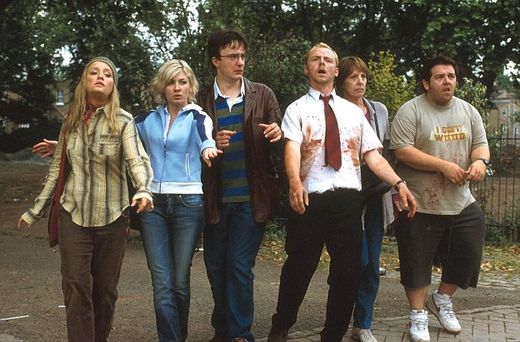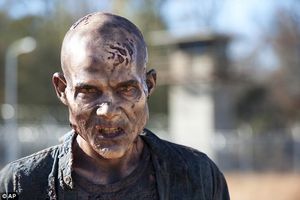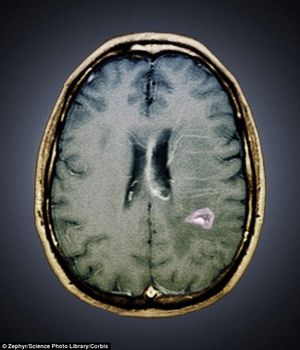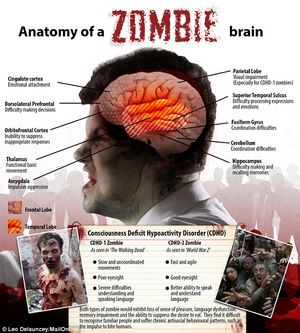Neuroscientists reveal the anatomy of the undead's brain, propose survival techniques
Their lumbering, menacing gait and insatiable hunger for flesh strikes fear into even the most seasoned horror film fan.
Now, two neuroscientists have analysed the behaviour of the walking dead to reveal the inner workings of their minds and defined a comprehensive diagnosis of 'zombiism'.
And with this knowledge they have even hatched a plan for how to survive a zombie apocalypse.
Neuroscientists have analysed the behaviour of the walking dead to reveal the inner workings of their mind and coined a diagnosis of 'zombisim'. This diagram shows parts of the brain that are responsible for certain zombie behaviours, such as impulsive aggression and difficulty processing emotions
Zombie fanatics Timothy Verstynen, an assistant professor in the department of psychology at Carnegie Mellon University in in Pittsburgh, Pennsylvania, and Bradley Voytek, assistant professor of cognitive science and neuroscience at the University of California, San Diego, summarised characteristic zombie behaviour seen in films, which can be explained by looking at the structure of the brain.
They have dubbed the condition 'Conscious Deficit Hypoactivity Disorder', or CDHD, which they describe as an acquired syndrome in which infected people lack control over their actions.
In films, the undead display symptoms such as lethargic movement, loss of pleasure, language dysfunction, amnesia and the inability to suppress hunger and aggression.
Hungry: Zombie fanatics Timothy Verstynen, of Carnegie Mellon University and Bradley Voytek, of University of California, San Diego, summarised characteristic zombie behaviour seen in films, including .
There are two subtypes of the syndrome - CDHD-1, which affects 'slow' zombies with uncoordinated movements and CDHD-2, which is typical of 'fast' zombies that have no problem chasing humans in films, such as and
[embedded content]
Theories to explain causes of the zombiism
The zombie apocalypse occurs in many different forms in zombie films.
- Space radiation -
- Chemical weapons -
- Biological infection -
- Genetic manipulation -
- Parasites -
- Magic -
- Supernatural possession -
- Depression -
'Zombies often have difficulty recognising familiar people and suffer chronic insomnia that results in a delirious state,' they write.
Undead individuals would also exhibit antisocial behaviour, such as biting and eating people, but they would be friendly to each other and swarm with other infected individuals, according to the scientists' book, .
The neuroscientists have come up with two subtypes of the syndrome - CDHD-1, which affects 'slow' zombies with uncoordinated movements and CDHD-2, which is typical of 'fast' zombies that have no problem chasing humans in films.
This may be because at the moment of death, our circulatory systems stop, starving the brain of oxygen and glucose.
In zombie films, they resume at the point of infection - in a limited form - and the brain gets its nutrients by zombies feasting on human flesh.
The longer the brain is starved of oxygen, the more extensive the damage to zombies, the neuroscientists say.
The brains of both types of zombies would change in different regions, from a combination of decreased activity and altered activity in multiple brain networks.
Lesions to the temporal lobe would partly cause zombies to act like they do in films.
Six Tips to Survive the Zombie Apocalypse
Don't fight: Zombies wouldn't have the neural responses to care about pain, so unless you could shoot to kill, it would be best to run for it.
Keep quiet: Zombies with CDHD would have very little memory and poor concentration, so if you hid, something else would likely capture their attention, keeping you safe.
Distract them: Damage to zombies' posterior parietal cortex would mean that they couldn't concentrate and would be at the mercy of whatever grabs their attention. Try fireworks for a quick getaway.
Out-run them: This only would only work with CDHD-1 zombies, who would only be able to lumber along clumsily.
Don't try reason: 'CDHD presents with a massive dysfunction of the language circuits in the brain. This means that zombies can't understand what you're saying, nor can they talk back,' the neuroscientists warn. Their 'fight' reaction would dominate, leaving you pleading with an angry hungry zombie.

Copy to survive! Zombies wouldn’t be able to recognise faces so they identify each other by movements and sounds. ‘If confronted with a herd of the undead with no clear avenue of escape, do what Shaun and his friends did in “Shaun of the Dead” – act like a zombie, the experts said
Mimic them: Zombies wouldn't be able to recognise faces so they identify each other by movements and sounds. 'If confronted with a herd of the undead with no clear avenue of escape, do what Shaun and his friends did in - act like a zombie. Do it with enough accuracy and you can wander through the herd undetected,' Professors Verstynen and Voytek say.
Specifically, damage to the fusiform gyrus would impair the undead's ability to recognise faces, while damage to the superior temporal gyrus would hamper their ability to process emotional facial expressions, resulting in apathy to the feelings of others.

Zombies are known for their poor eyesight and visual impairment would come from damage to the parietal lobe. It perhaps explains why CDHD-1 zombies, such as those seen in the TV show, The Walking Dead (screenshot pictured), can only look straight ahead and see one object at a time in films
Professors Verstynen and Voytek say lesions in the temporal parietal junction - an area of the brain where the temporal and parietal lobes meet - would result in severe difficulties in understanding language and in speaking; making communication difficult and causing slurring, as seen in films.
Meanwhile, damage to the medial temporal lobe - especially the hippocampus, which is responsible for memory and navigation - would mean that zombies couldn't form new memories and would find it hard to find their way around towns, giving humans a change of surviving an apocalypse.
Zombies are known for their poor eyesight and visual impairment would come from damage to the parietal lobe. It perhaps explains why CDHD-1 zombies can only look straight ahead and see one object at a time in films. Problems with spatial attention as a result of this injury, would also make general motor skills difficult.
CDHD-2 zombies, however, would not suffer as much damage to this brain region, according to the scientists.
But both types of zombie would have sustained 'extensive damage' to the frontal lobe, which is responsible for immediate tasks, planning, and motivation.
The inability to suppress inappropriate responses, such as the desire to eat people would be due to damage in the orbitofrontal cortex, while damage to the dorsolateral prefrontal cortex would make decision making difficult.
Lesions to the interior frontal cortex, especially Broca's area,which is linked to speech production, would result in communication difficulties.
Damage to the cingulate cortex would mean that individuals may feel conflicted about emotional attachment to people and eating them, but they would not be able to suppress the desire to eat.
The cerebellum, a region of the brain that plays an important role in motor control, would likely degenerate in CDHD-1 zombies, explaining their severe coordination difficulties in films.
'Individuals exhibit a wide stance and lumbering gait as well as difficulties reaching and grasping,' professors Verstynen and Voytek write.
Damage to this area of the brain would also lead to slurred speech, but CDHD-2 zombies would be spared extensive cerebellar damage, making them more eloquent.

© Zephyr/Science Photo Library/Corbis
In humans, tapeworms (shown in an MRI scan) can make its way into the brain to change our behaviour, but a microbe called Toxo plasma gondii (T.gondii) goes a step further. Found in cat faeces, it can infect humans and stop them fearing risky behaviour, with tragic results
Zombies' insomnia could be explained by lesions in the hypothalamus, which links the nervous system to the endocrine system.
In the mid-brain, lesions to the amygdalae - two almond-shaped groups of nuclei located deep within the temporal lobes of the brain - may explain enhanced fight or flight behaviours in zombies on the silver screen, expressed as impulsive aggression.
However, primary sensory areas of the brain that allow humans to process sights, sound, smell, touch and taste signals would remain intact, meaning that zombies could use all sensory information, but wouldn't respond emotionally to it.
Some areas of the brain allowing basic movement, such as the thalamus - which is used to process neural signals - and the brainstem, would function as usual upon infection, the neuroscientists explain.
'In conclusion, the series of brain changes seen in CDHD, reflect a loss in so-called "higher order" cognition areas and the neocortex the CDHD-1 subtype also reflects a degeneration of the cerebellum,' they say.
How can science fight the Zombie Apocalypse?
- If neural programming causes CDHD, scientists could 'hack' the brain itself, perhaps using experimental stem cells to re-grow damaged parts of the brain itself. Scientists have tried a slightly similar approach to cure Parkinson's disease, by replacing a certain type of neurons. Bur replacing dead cells with living ones would be a temporary fix, because whatever killed off the original living cells could attack the new ones too.
- A procedure called 'deep brain stimulation' (DBS) could be used to 'turn on' parts of the brain, with help from implanted electrodes, which could even be used to control zombies. However, the neuroscientists warn that this would be a long-shot because it would take too long and CDHD affects multiple brain areas.
- A direct current could be applied to the scalp of zombies using a battery to stimulate tissue, causing neurons to fire and make them more 'human' again. The technique would not cure zombiism, but it might moderate the undead's aggressive urges.



0 reacties:
Post a Comment